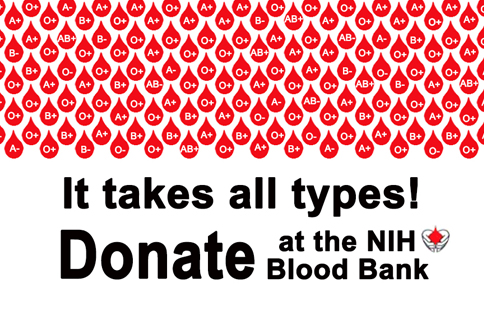Clinical Center's Blood Bank plays a vital role in treatment and research
Donor pool has dropped by 25% due to the pandemic

Blood is essential to life and health. Prolonging life and improving health are at the foundation of the NIH Clinical Center’s mission, so maintaining an adequate and safe blood supply is vital to so much of what happens in the hospital. The NIH Blood Bank is where it all begins
The NIH Blood Bank has two locations: one in the Clinical Center on the NIH campus in Bethesda, Md., with an additional donor center in nearby Rockville, Md. The Clinical Center focuses on whole blood donations, where all blood components are collected in a single visit. The Rockville location offers easy access for community donors and collects only platelet and ‘double red cell’ donations, the latter being a specialized process where one donor can provide two units of red blood cells at one time while sparing the other elements of blood compared to conventional single unit donations.
As a part of the Clinical Center’s Department of Transfusion Medicine (DTM), the Blood Bank manages blood donations from its generous donors. Many donors are recruited from the local community but NIH staff and some patients and families represent a substantial proportion of blood donors - in 2019, 55% of blood donors were either NIH staff or patient family members. DTM uses most of these donations for transfusions in support of patient care at the hospital. About 20% of all blood donations are used for research conducted in over 200 NIH and U.S. Food and Drug Administration (FDA) scientific laboratories. Additionally, the DTM collects cellular products for development of experimental therapeutics for various illnesses, from sickle cell disease to many cancers.
“The Blood Bank obtains the blood used in transfusions for both adults and pediatric NIH patients,” said Al Decot, the Blood Bank’s marketing coordinator.
“Red blood cells are frequently used to treat patients with anemia related disorders, platelets are needed for blood clotting for bleeding patients, and granulocytes - white blood cells - are needed for patients with infections.”
Many NIH Institutes and Centers need a reliable blood supply for experimental and routine treatments, as well as laboratory research. The Blood Bank remains in continuous communication with patient care teams in the Clinical Center to anticipate their needs. All blood products used for NIH patients must meet the same FDA regulations that other organizations, such as the Red Cross, must meet. Donations used for research purposes are categorized and inventoried differently, having less restrictive criteria for donor eligibility.
Recruiting new donors through NIH-based blood drives and cooperative efforts with external organizations is key to maintaining an adequate supply. This has become more challenging as the COVID-19 pandemic reduced the active donor pool by 25%.
Significant efforts are made to ensure a pleasant donation experience for new and returning donors. To ensure donating is safe for the donor, a detailed questionnaire is completed to identify risks for potential complications. People donating blood must be at least 17 years old, and the Blood Bank works hard to expand their pool of younger donors to help complement the roster of older donors who cannot donate as frequently. There is no upper age limited as long as donor health is stable and established criteria are met.
Other screening rules are applied to assure donated blood is free from many potential types of blood borne infections. The FDA sets the screening criteria, which evolve as ongoing studies provide new information regarding donor eligibility and infectious dangers to the blood supply.
“Blood banking historically started with donors being paid. Then about 50 years ago, screening became increasingly recognized as an absolute necessity and paid donations were phased out with screened voluntary donations replacing them as a way to begin ensuring the safety of donated blood,” stated Dr. Leonard Chen, Staff Clinician of the Blood Services Section in the Department of Transfusion Medicine.
“The FDA and CDC carefully monitor the blood supply - right down to geographic regions, where certain types of infections may be more prevalent, and even for pathogens that are more likely to occur in certain seasons of the year,” added Chen.
Collecting a variety of blood types is key to maintaining a healthy blood supply. There are eight main types of blood: A, B, AB and O which can be either RhD positive or RhD negative. Group O (positive and negative) can be used for most patients who need blood transfusions and is constantly in need, along with platelets, which only have a short, five-day shelf life.
Using a patient’s correct blood type is vitally important as transfusion of an incompatible type can cause damage to multiple organs or even death.
“The blood type really clues us into to what kind of cell donation will benefit the patient the most. Sometimes there’s lab work involved to find what tranfusable product will be best for a particular patient,” said Decot.
The Blood Bank has invested time and resources into screening to ensure donations are safe for the blood donor and recipient.
“Don’t automatically rule yourself out - potential first-time donors should not assume that age, a particular health condition or other concern will inevitably lead to not being accepted as a donor. If anyone has questions about eligibility, call us to find out if you can help save lives,” added Decot.
- Robert Burleson
Interested in donating blood at NIH?
Prospective donors for the NIH Blood Bank can make the first step by visiting our Blood Donor page or by calling 301-496-1048 to donate blood and 301-496-4321 to donate platelets.